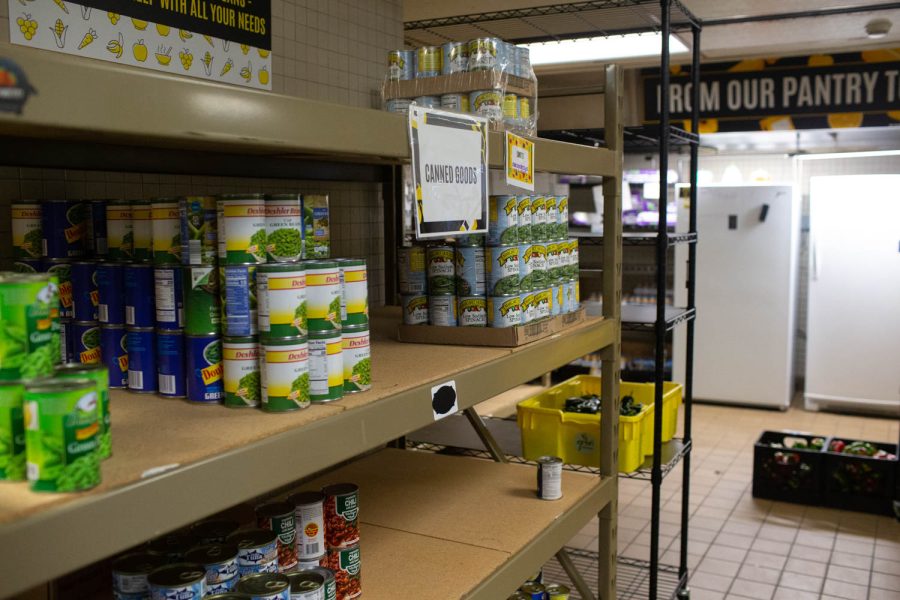UI food pantries experience limits on multicultural food options
Multicultural foods often cost more to purchase, leading to higher rates of food insecurity for people of color, as well as the potential shift away from familiar childhood dishes due to cost.
Canned Goods sit on the shelves at the Food Pantry, on Wednesday, Oct. 5, 2022, at the Iowa Memorial Union.
October 9, 2022
The University of Iowa’s food pantries are struggling to stock diverse food options as prices for groceries remain high.
The UI’s two food pantries distributed approximately 100,000 pounds of food to university faculty and students last year. The pantries have an east side location at the Iowa Memorial Union in Room 278 and a west side location at the Pride Alliance Center at 125 Grand Ave. Court.
Both pantries are still struggling to meet the demand of students and provide a diversity of food.
Stephanie Beecher, UI basic needs coordinator in the Office of the Dean of Students, emphasized the impact this massive increase in prices has on those visiting the food pantry.
“We’re seeing a huge increase in the number, but the amount of food we’re taking in is staying the same,” Beecher said. “Last year at this time, the average amount of pounds of food that one person would take is about 26; now we’re at 13.”
The food pantries rely on donations from a variety of food sources, Beecher said, but donations can be unpredictable and leave gaps in food stock. The pantries also have to consider their budgets when purchasing diverse food options.
“I think 80 percent of our clients are not white, so getting those diverse foods, that’s about 2 percent,” Beecher said, “That’s definitely an area where we’d love to increase, but also the cost of food, especially multicultural foods, fishes, inflation is killing our budget.”
According to the 2021 Iowa WIC Food Security Survey Report, food insecurity is more common among people of color:
- 7 percent of Black households experienced food insecurity in 2020.
- 2 percent of Hispanic households experienced food insecurity in 2020.
- 1 percent of white non-Hispanic households experienced food insecurity in 2020.
Jade Nguyen, UI student and assistant programmer at the Asian American Cultural Center, said sometimes the food pantries have diverse food options but it’s not guaranteed.
“I have gone to the food pantries on campus a couple of times, and I don’t know if it was just the times that I went, but like the food was pretty sparse,” Nguyen said.
Nguyen has changed her eating habits while at the UI primarily because of high food prices.
“I’d say for the most part the food that I eat is definitely very different from what I ate growing up,” Nguyen said, “Because like I can tell the difference between me shopping at like Aldi – which is like one of the cheapest places for me to get food – versus going to like an Asian market where a lot of things will be double the price.”
RELATED: Iowa City community wrestles with rising food prices
She added that Iowa City has a limited supply of Asian grocers.
“There’s a couple. There’s Starlight Market and also Chong’s Market, [and] they’re right across the street from each other. They’re a little bit closer to Coralville,” Nguyen said, “Otherwise, there’s like a little Korean Market that’s on Gilbert, and there’s like Asia Plus, but that’s mainly snacks and stuff that’s at the Old Capitol Mall.”
Nguyen said the Shin Rhuymen, a South Korean instant noodle brand that’s popular with the students at the UI’s Asian Pacific American Cultural Center, is more expensive than the instant ramen found at Walmart, which costs less than a dollar.
“Like a pack of 18 or so, it’s like 40 bucks at Chong’s Market, and I was like, ‘Damn, that’s rough.’” Nguyen said.
Nguyen, a Des Moines native, said the price increase may be due to less diversity in Iowa City and limited grocery options for Asian dishes.
“I don’t know if it’s like that part of it where my environment has changed, so that’s why like the price difference,” she said. “But yeah, I’m not sure.”















